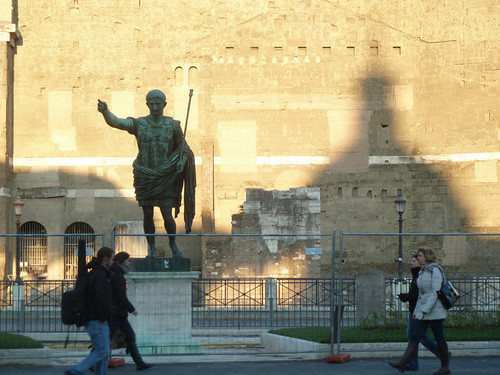
Some years ago I went to Florence and Siena. The image of dining in Italy that Americans have is idyllic— every Olive Garden ad bloodsucks that image of the table of hearty food and warm family in our collective head— so it often surprises people when I say that I found it almost impossible to find anything good to eat on that trip. Well, for dinner; for lunch we would stop at the central market or the bakeries nearby, and that stuff was always cheap and fantastic. Here was the bounty of amazing-tasting simple stuff that is Italy’s birthright. But let them actually cook it into a dish… there was the pasta place so bad we waved other tourists away, like the damned warning the living that there was still time to save themselves, and there was the Florentine steak place we picked out of Michelin which forever defined Michelin for me (snobbish, insanely expensive, twenty years behind the times). Honestly, one of the best dinners we had in Florence was Chinese food. It was almost as good as the old school Cantonese in Wichita.
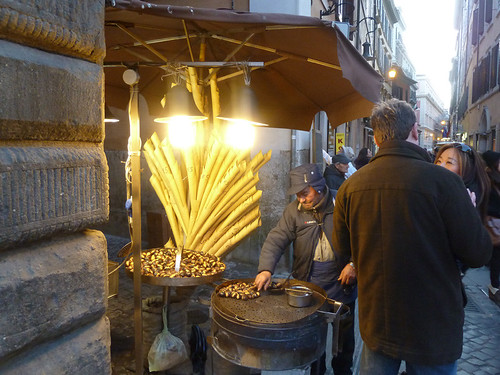
Now it is many years later, Chowhound and LTHForum and Sky Full of Bacon and Grub Street Chicago later, and I think I understand better how to avoid crap places and suss out promising ones, in any culture. First, of course, is just to go where someone you trust says you should go; more on that anon. Second is learn how to recognize the signs of crap for tourists— the Coca-Cola-branded signage promising menu turistico, the lavish gelato bar (Americans are drawn to vast arrays of sweets like bees to flowers), etc. I’m not going to say we scored 100%, there were a couple of meals where we wound up spending $50 to feed the four of us hospital cafeteria sandwiches, but I also had several scores where we picked a place, a humble bar or bakery, and spent a relative pittance to have fresh-tasting, beautiful homecooked food served up by a smiling Italian mama or gent straight out of a 50s movie. Like this place:
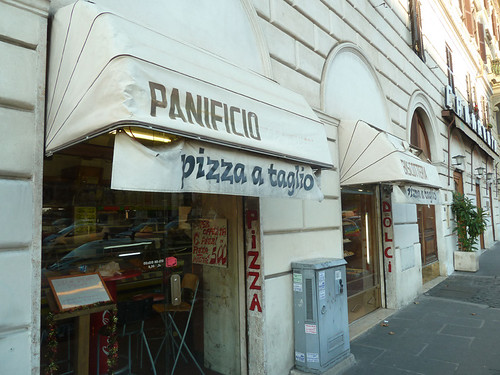
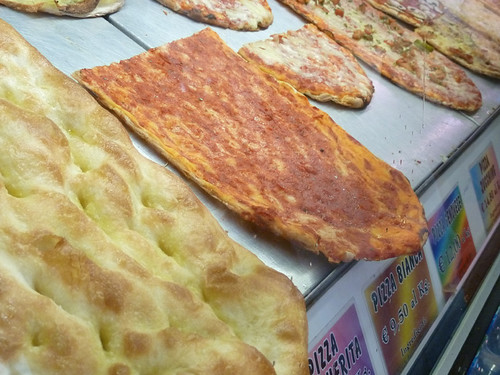
This was the bakery just around the corner from our friendly B&B near the Colosseum, facing the Basilica di San Giovanni in Laterano, and I could find its address for you, but I don’t want to recommend it (unless you stay at the same B&B), I want you to be able to find yours near where you’re staying. A bustling little bakery, freshly made sheet pizza (pizza al taglio) with simple toppings like ham and mozzarella or potato and rosemary, desserts, a few tables crammed into a space right in front of a door, traffic in and out, stuff like this in the morning:
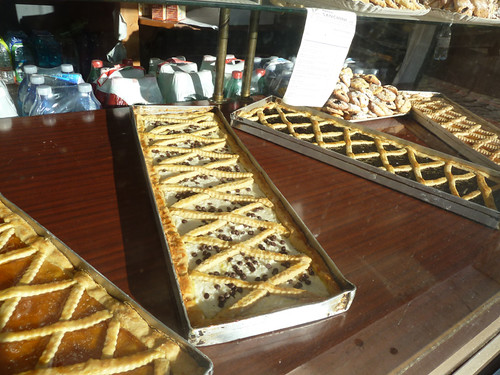
And it cost nothin’ and I felt like a million Euros for being able to recognize it and direct my family there just a couple of hours off the plane. Same thing when we went to the Vatican, we stopped on the way for a coffee and pastries before our time in the Sistine Chapel (allow me to highly recommend going at Christmas, not because they do all that much different then— it’s not really a place that needs extra religious-themed decoration— but the crowds were a fraction of what they’d be in the high season). The place we stopped was just a little cafe, nothing special:

Luckily I didn’t see the Coca-Cola sign till after. Anyway, coming back at lunchtime we had a recommendation for a nice, if expensive lunch, and we got to it and they were still setting tables and vacuuming, wouldn’t open till 1 or 1:30, so we walked half a block back to the cafe to have something to tide us over for a half hour or so. And we sat there, and guys like this:

were feeding an obviously local crowd with stuff like this:
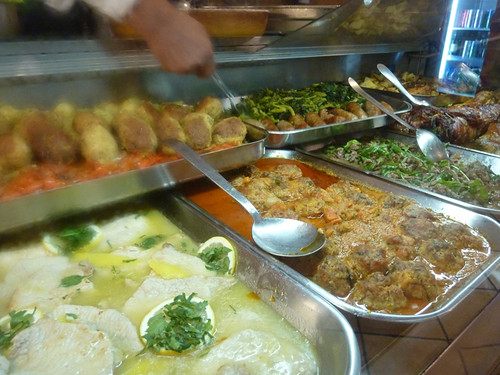

And it all smelled really good and was dirt cheap and I thought, are we chumps for waiting to eat a $100 lunch for four when this stuff is being served up all around us? Yes, we were. So we stopped being chumps and just had them make up plates of enough food for six or eight, and it was maybe $35 (and half of that was Cokes), and we dug in, and were happy as could be.
Or when we went to this place (again, because a lunch choice wasn’t open yet, after seeing Bernini’s St. Theresa):
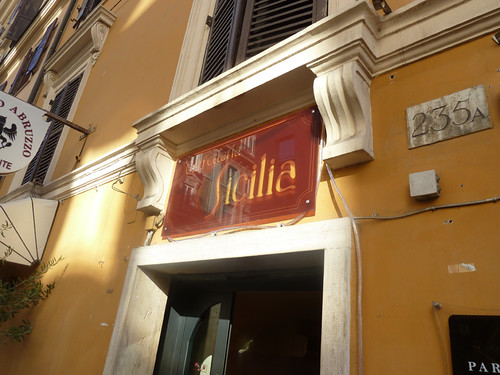
And while we were waiting the guy came by with the fresh mozzarella and the mama opened the box and jabbed toothpicks in a couple of them and handed them to us to try:
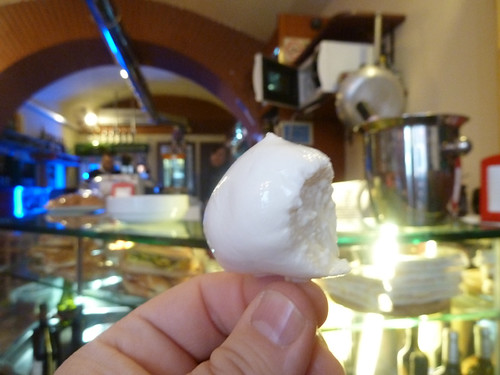
And on and on like that. One thing I learned along the way: nobody knows how to microwave like the Romans do. Because that’s how a lot of this food was heated up in these little cafes and bars; they don’t have room or time for a big oven, they just pop it in the microwave, yet it was never hardened and rubberized like food is when American restaurants microwave stuff. I suspect part of it is that our microwaves are simply too powerful, compared to theirs; we death-ray our food by comparison. For once the fact that everything in Europe is smaller and underpowered was an advantage. Whatever it is, they know how to use technology without destroying the tradition the food comes out of.
* * *
Now, one place I would unquestionably recommend, just as it was recommended to me— actually, two different parts of the business were recommended to me separately, and I didn’t realize they were the same place until we got there. It’s Roscioli, which you might call kind of the Zingerman’s of Rome— a group of businesses devoted to presenting the best artisanal foodstuffs, which may seem redundant in Rome, but in a city where that humble bar-ball of mozzarella on a toothpick was something special, Roscioli’s are a cut or two above even that. Jared Van Camp recommended the main store for its stunning collection of cured meats from all over the region, as well as the chorus line of prosciutto and jamon iberico legs poised above the salume:

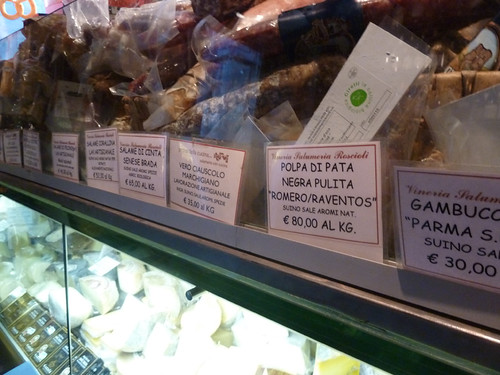
Looking at their website, I saw that Roscioli also served dinner— as it turned out, kind of a popup dinner spread throughout the store. Dining among the olive oils and salume was an irresistible idea, and so we went:

It’s not, I think, that there’s some great chef here, but there’s a good chef making the same stuff you’d have elsewhere, but with ingredients sourced at Roscioli’s level of quality, like a gooey alien-egg of burrata topped with shaved white truffle (you pick the amount by the gram):

Or this platter of mostly housecured meats, including a fantastic testa and a speck-like ham:

Cacio e pepe, the most everyday Roman dish, elevated by the outstanding quality of the parmesan:
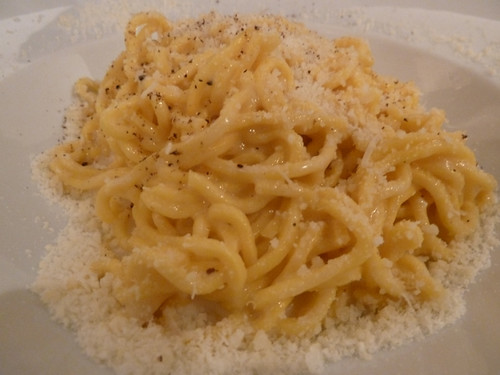
Which brings us, though, to a conundrum. Roman pizza, wherever we had it, was great just because the bread was so fresh and simple and delicious, whatever you put on it got a gold frame for its own flavors. But I didn’t feel that way about Roman pasta at all. The best pastas we had were at Roscioli because the best things went in the pasta. Other pastas we had were fine, satisfying enough, but without Roscioli’s sourcing, they were no better than things I’ve had in many places in Chicago, and the pasta itself was always serviceable, not one of those things that makes you go, aha, so that’s why pasta. This was the case at Luzzi, a frequently-recommended-in-guidebooks spot near our B&B, where the wood burning oven’s simple products infinitely outshone our homey (in the not entirely flattering way)* pastas:

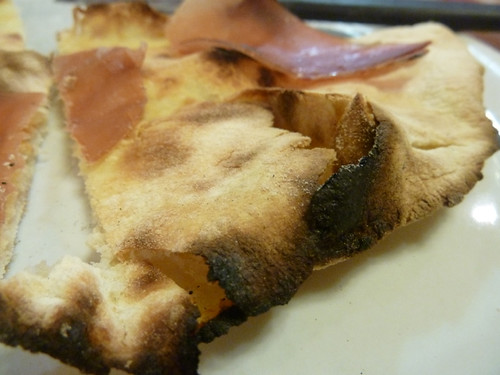
I frankly feel there’s more devotion to making great pasta in or about to unveil itself in Chicago (Nellcote, Balena, etc.— at least that’s what their press releases promise) than we saw anywhere in Rome; if there’s someone in Rome obsessed with making the world’s greatest authentic preindustrial pasta, a Poilane of pasta, we didn’t eat his stuff.
Anyway, meanwhile Michael Morowitz had recommended a place called Antico Forno. The trouble was, that just means “old-style oven,” there are “Antico Fornos” all over Rome. What he meant was just up a side street from Roscioli:
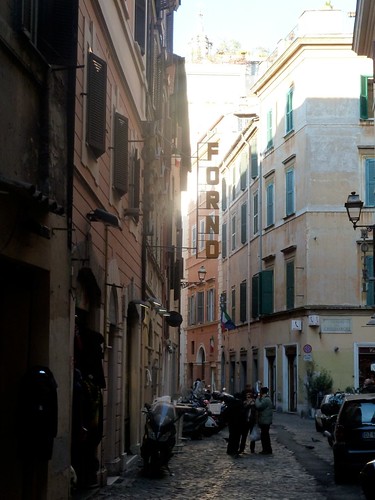

This was Antico Forno Roscioli, a bustling bakery with lots of food to go (and almost nowhere to eat). There was sheet pizza:
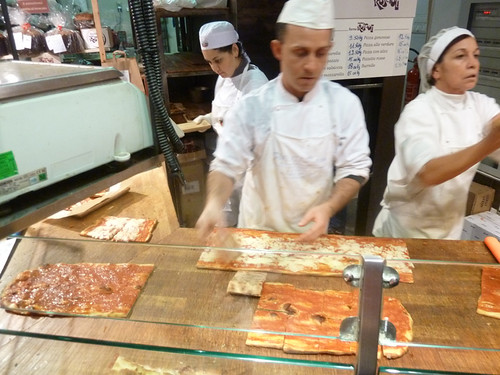
and an amazing array of baked goods for the Christmas holiday just a couple of days away:

We bought it and sat on the steps of this chapel a block away, like the poor with their crusts of bread:

Except we had this, the greatest ham sandwich of my life, as I mentioned in my ten best list for last year:
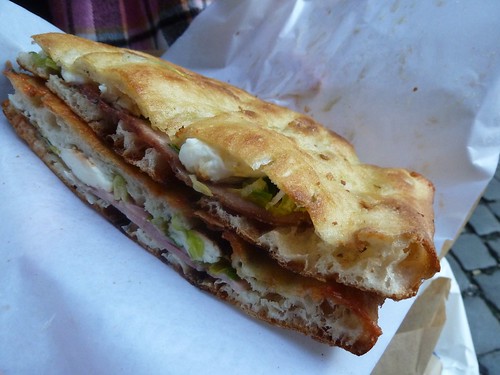
Another recommendation from Morowitz was a tiny bakery in the Jewish quarter— more the Jewish block— which he said specialized in a kind of chocolate ricotta cake. Alas, after standing in line for twenty minutes, crowded into it like a phone booth, the ricotta cake was sold out (not sure why the Jewish bakery was as busy as all the others right before Christmas, but it was). I came away with slightly burnt biscotti:

And the irony of remembering that I had seen exactly the thing I’d come here for earlier that day… at Roscioli.

I bet they do a great job with it, too.
Another pizza place that was widely recommended to me, notably by Tony Mantuano who says it inspired the pizzas at his new Bar Toma, was Pizzarium, which I wrote about more fully at Grub Street. It’s just a walk-up stand in a fairly modern neighborhood on the outskirts (easy to get to, though, since it’s just up the street from the Cipro metro stop), but renowned for the excellence of the sourdough crust, which more than Bar Toma’s, reminded me of Great Lake’s (and has a similar overnight retarding period before it’s baked).
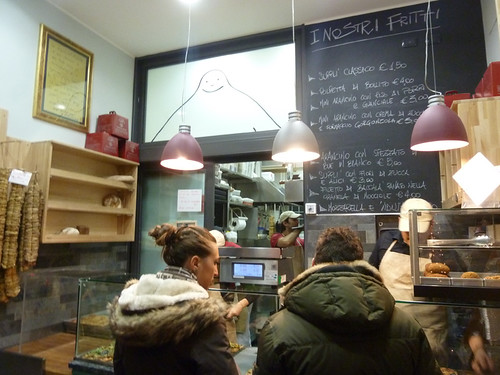
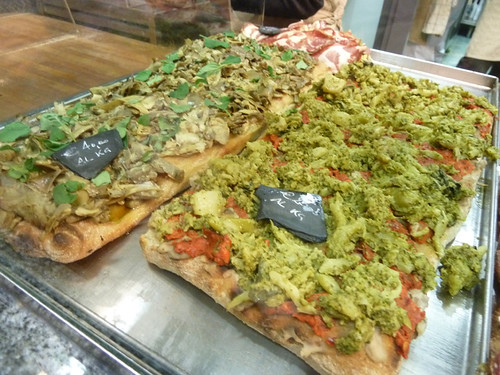
There were all kinds of toppings— I regret passing on one that had mandarin orange slices on it— but again, simplest was often the best; the tomato bread with burnt spots was magical. Pizzarium, like Rome generally, demonstrated to me anew that the secret to eating well in Italy is to spend as little as possible… in exactly the right places.
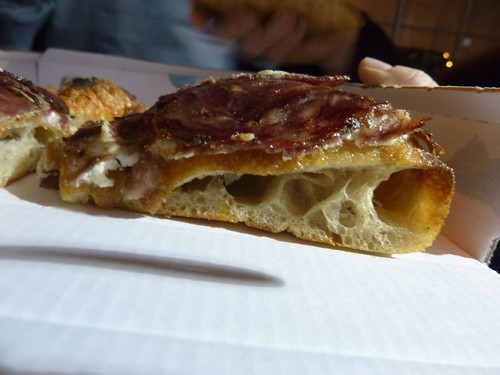

__________________
A few extra notes:
* Better in all departments (especially the warm Italian mama welcome) was I Clementini in the same neighborhood:

That said, one night when we were tired we did return to Luzzi and stuck to pizza, and were all happy.
Gelato is everywhere, but everyone seems to agree that one place, off the Trevi Fountain, is a standout, Il Gelato Di San Crispino:
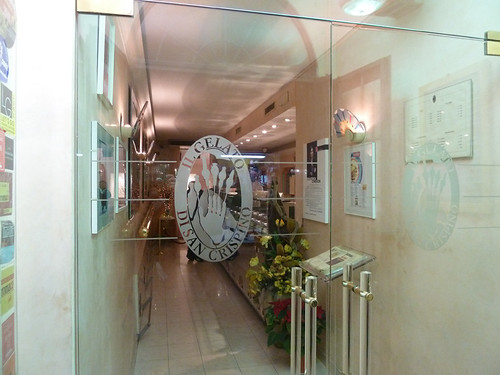
This despite being a bit surly and having few places to sit. I’d agree— for the fruit gelati, especially the pear (praised in the NY Times) and some of the fig ones. Dairy ones seemed less outstanding to me— fine, but not unique.


 If you like this post and would like to receive updates from this blog, please subscribe our feed.
If you like this post and would like to receive updates from this blog, please subscribe our feed.




